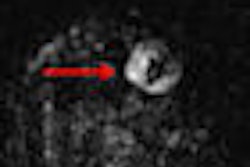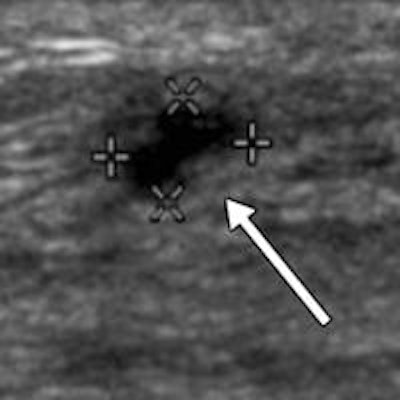
Breast lesions categorized as "probably benign" on supplemental screening ultrasound are rarely malignant and could be re-evaluated at 12 months rather than six -- reducing patient anxiety, follow-up exams, and unnecessary biopsies, according to a study published online in Radiology.
Dr. Richard Barr, PhD, from Radiology Consultants in Youngstown, OH, and colleagues analyzed data from the American College of Radiology Imaging Network (ACRIN) 6666 trial to ascertain the frequency and malignancy rate of ultrasound lesions categorized as BI-RADS 3. In ACRIN 6666, both annual mammography and ultrasound screenings were performed on women with dense breasts at 21 sites around the country.
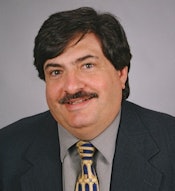 Dr. Richard Barr, PhD, from Radiology Consultants.
Dr. Richard Barr, PhD, from Radiology Consultants.
Current guidelines say that these lesions should be monitored for suspicious changes with imaging at intervals of six, 12, and 24 months, according to Barr's team (Radiology, August 20, 2013).
"BI-RADS category 3 lesions are common at work up of screening mammographic abnormalities, occurring in 6% of examinations, and despite their low malignancy rate, they require additional follow-up or even biopsy that results in substantial patient anxiety," the group wrote. "The purpose of this analysis was to prospectively evaluate predefined BI-RADS category 3 criteria in the ACRIN 6666 multicenter setting."
Out of 2,662 trial participants recruited between 2004 and 2006, 519 (19.5%) had 745 BI-RADS 3 lesions on ultrasound, representing 25% of all ultrasound-detected lesions in the study, according to the authors. Of these lesions, 124 (16.6%) were biopsied, and six of these biopsied lesions were malignant (representing 0.8% of BI-RADS 3 lesions). The average size of the detected cancers among the BI-RADS 3 lesions was 10 mm.
During follow-up imaging at six months, suspicious changes were observed in only one of the 745 lesions characterized as BI-RADS 3. At 12-month follow-up, suspicious changes were observed in a second BI-RADS 3 lesion, revealing an invasive breast cancer that had not yet spread beyond the breast.
"It looks like even the ones we miss in this category still have the same prognosis a year later," Barr told AuntMinnie.com.
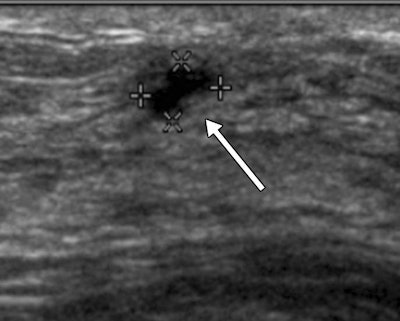 Sonograms show a BI-RADS category 3 lesion (arrow) in a 43-year-old woman. The lesion was described as 5-mm clustered microcysts at one-year follow-up (above). At two-year follow-up (below), the lesion had suspicious changes and was reclassified as a BI-RADS category 4A solid lesion. The lesion was not detected with mammography in either year. At biopsy, the lesion was determined to be an 18-mm invasive lobular cancer. Images courtesy of RSNA.
Sonograms show a BI-RADS category 3 lesion (arrow) in a 43-year-old woman. The lesion was described as 5-mm clustered microcysts at one-year follow-up (above). At two-year follow-up (below), the lesion had suspicious changes and was reclassified as a BI-RADS category 4A solid lesion. The lesion was not detected with mammography in either year. At biopsy, the lesion was determined to be an 18-mm invasive lobular cancer. Images courtesy of RSNA.
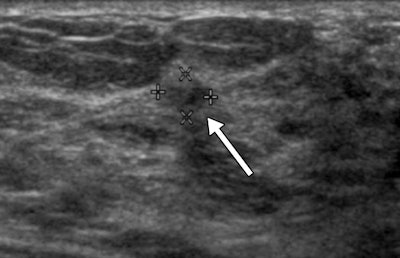
Barr's team also found that women in the study with BI-RADS 3 lesions were more likely to be younger than 50 years old, of Hispanic or Latino ethnicity, and premenopausal.
Ultrasound is being used more and more as a supplement to screening mammography because it can find breast cancers that mammography may miss, such as those in dense breasts, Barr said.
"Breast density notification legislation is driving increased use of screening ultrasound," he told AuntMinnie.com. "And since we're conducting more ultrasound screening, we're finding more BI-RADS 3 lesions. One-year follow-up may be a way to eliminate unnecessary biopsies and alleviate patient anxiety. Of course, diagnostic situations are a different story."
In the hope of further identifying malignancies in BI-RADS 3 lesions, Barr is currently conducting additional studies on the use of elastography.
"Adding elastography to ultrasound screening may also help us pick out those few lesions categorized as BI-RADS 3 that turn out to be cancer," he said. "At our institution, the sensitivity and specificity of elastography is 100% and 90%."








